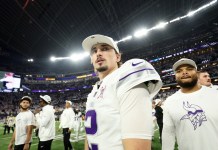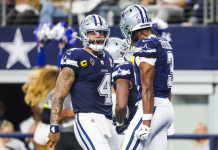Why Miami Should Be Concerned for 2024
When the Piqua Auto Supply House of Piqua, Ohio, took out an advertisement in the local paper, the headline read, “One Look is Worth a Thousand Words.” They didn’t realize that line would last a lifetime. The company was attempting to lure customers into their store on Main Street to examine their vast collection of tires. Ever since, the catchy phrase has been used in ads, songs, and movies. And today, it was the perfect phrase when I saw a picture of the new slimmed-down version of Miami Dolphins quarterback Tua Tagovailoa.
When I first saw the video and picture of Tua on Miami Dolphins reporter Giselle Espinales’ X account engaging with fans, I did a double take. He looks young, lean, tan and small. Very small, with a slender almost in swimsuit model shape, not football. It was hard to tell who the professional athlete was.
The picture caused me to ask myself: What happened to the Tua who needed to get bigger and avoid being in the concussion protocol? Why change his approach to his body when it worked? Last year was the first time he was able to stay healthy for all 18 games, mainly due to his increased size and avoiding the bad hits. Now, as his agents are negotiating a new deal rumored to be in the fifty million per year range, Tua decides to lean down. It doesn’t make sense, causing me to wonder what the hell is going on in South Florida.
Tua has been in and out of the offseason program in Miami, which doesn’t create any concerns as most players looking for a new deal believe their absence can create teams to negotiate with a sense of desperation. It doesn’t, but agents think it works to their advantage.
And even though the Dolphins have many moving parts, particularly on defense, their offense will be the same, with the exception of head coach Mike McDaniel trying to get the tight end position more involved. Last year, Tua targeted the tight ends 52 times out of 549 throws, resulting in 41 catches out of 393 receptions. Their target rate was less than ten percent, and their reception rate was right at ten percent. Why would they need to throw the ball to any tight end with Tyreek Hill and Jaylen Waddle dominating on the edges?
In contrast, Hill and Waddle accounted for 44% of the passes targeted and 74% of the receptions. By adding Jonnu Smith and Jody Forston, McDaniels wants to force the defense to acknowledge the tight ends in the offense. Smith can run and is best with the ball in his hands. Look for him to run either down the field patterns, over routes in the RPO offense or be utilized in the slip screen game because he is hard to tackle. He isn’t a polished route runner as he needs to build speed as the pattern develops. However, he does give the Dolphins another fast player for the defense to defend.
For Tua to stay healthy, he needs protection, and based on his body this season, his protection will need to improve. McDaniel does a great job of running an offense that relies on quick throws, yards after the catch, and doesn’t ask the offensive line to hold their blocks for long. If they ran a conventional offense, with mediocre receivers, the line would be exposed as a huge weakness. McDaniel hides their flaws with the RPO game, and Tua throws the ball with great rhythm to certain places on the field.
Early in the season, defensive coordinators were having a hard time slowing down the Miami attack. Once they realized the ball was being thrown to certain areas of the field, Tua’s second-half numbers went way down.
Good defensive coordinators understand how to defend the Miami offense—this doesn’t imply they can, only they know how, as Miami’s skill is elite. It does explain why they melt in the second half of the season, why Kansas City held the Fins to 188 yards passing in the Wild Card game and 175 yards in Week 9. In six of their seven losses, the Dolphins were held to less than 222 yards passing, with their only win coming against the Jets in Week 15.
Another reason why they melt might have to do with all the players complaining about Vic Fangio working them too hard. In Miami, each coordinator runs their side of the ball. McDaniel doesn’t involve himself with the defense, only controlling the practice time on the field. Fangio felt that some of the Miami players were not interested in working hard and were more interested in hitting South Beach. Let’s face it, Miami offers an array of entertainment for any young professional athlete with cash. If the players’ focus isn’t on the game, the town can become a distraction.
Fangio and McDaniel was an odd partnership from the start. McDaniel is hip, cool, a players-friendly coach who wasn’t going to hold anyone accountable—which irritated Fangio. Ron Jaworski, a longtime friend of Fangio, said, “There were some players on that defense that didn’t want to work. Didn’t want to put the time in, didn’t want to put the effort in, didn’t want to make the commitment to be successful.”
As Vic tried to push the players, they resisted, and McDaniel sided with the players. Does this divorce mean things will be better in the second half of this season? Since becoming the head coach, McDaniel is 4-10 from Week 13 on, including playoffs, in which one season was absent Tua and one wasn’t.
This year, from Week 13 on, they travel to Green Bay for a Thursday night game, home vs. the Jets, then on the road against Houston, home vs. San Francisco before ending the season on the road against Cleveland and the Jets. Three cold weather games have to scare Miami, and all of us thinking of betting them over nine wins. With Miami’s lackadaisical late-season practice approach, which caused Fangio to move on, the schedule isn’t going to offer any relief.
Now, the lackadaisical approach is Anthony Weaver’s problem. Weaver is a good coach, with only one year of defensive coordinator experience. In 2020, Weaver oversaw the Texans’ defense, which finished 30th in yards, 27th in points allowed, 32nd in creating interceptions.
His background centers on the front seven, not the coverage, which is why Miami hired Joe Barry formerly of Green Bay, to work with Weaver. Can Barry offer secondary coverage help even though he is listed as the run game coordinator? Run defense was the Packers’ biggest problem the last two seasons, which is why Barry was removed. This partnership will be fun to watch—as will how the Dolphins incorporate all the new pieces on defense. It’s easy to make fun of Fangio as some players have done upon his exit, but neither Weaver or Barry have his skill as a strategist or playcaller—at least not yet.
Christian Wilkins will be impossible to replace. Not only was Wilkins their best run defender, but he was also by far their best defensive lineman at hitting the quarterback, leading the team with 23 quarterback hits. Add in that Bradley Chubb and Jaelan Phillips are both coming off of major injuries, and the Miami front is going to need time to jell. And Weaver will need time to become a good coordinator.
Is 2024 the time Miami breaks through and wins the East, something they haven’t done since 2008? With questions surrounding Tua’s new look, their defensive makeover,r and most importantly, their inability to play their best late in the season, it makes me wonder if they are even better than the Jets, assuming (yes, I know the Iffers are a big assumption) Aaron Rodgers is healthy. There are so many moving pieces in Miami that all of us need to be concerned. Those concerns sparked by a picture of Tua caused me to write more than a thousand words.






